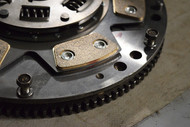What Is a Flywheel and How Does It Work?
14th Apr 2023

A flywheel is an important part of all manual transmission vehicles. Consisting of a heavy disc, it promotes a smoother ride. Most drivers, however, aren't familiar with the flywheel. If you drive a manual transmission vehicle, you might be wondering what a flywheel is and how it works.
What Is a Flywheel?
A flywheel is a drivetrain component located between the engine and the transmission. It's designed to smooth out the rotational movement of the crankshaft.
When driving, a mixture of gas and burn will burn in your vehicle's engine -- specifically the combustion chamber. These compression strokes will create powerful pulses of energy that, if left unchecked, can create a bumpy ride. The flywheel's job is to absorb and store some of this energy so that the crankshaft rotates more smoothly.
How Flywheels Work
Flywheels work automatically by storing and releasing energy in response to combustion. Some of the energy from the engine's compression strokes will be transferred to the flywheel as kinetic energy. The flywheel will then release this kinetic energy to maintain the crankshaft's rotational movement.
By assisting the crankshaft with rotational movement, the flywheel will promote a smoother ride. It will also prevent the crankshaft from slowing down too quickly or stalling.
Most flywheels are made of high-strength materials, such as steel, carbon or aluminum. With their heavy-duty construction, they can withstand the rotational speeds and mechanical stresses of a vehicle's engine. Furthermore, flywheels are precisely balanced to minimize vibrations and promote smooth operation.
Can You Drive With a Bad Flywheel?
Depending on the severity of the damage, you may be able to drive with a flywheel, though it's certainly not recommended. You can expect a bumpier ride if your vehicle has a bad flywheel. Without the assistance of this drivetrain component to store and release energy, your vehicle's engine will vibrate more aggressively, resulting in a bumpier ride.
If your vehicle's flywheel is severely damaged, it may break apart. And since the flywheel is connected to the crankshaft, it may cause catastrophic damage to your vehicle's engine or even the transmission.
The best course of action is to replace a bad flywheel as soon as possible. Driving with a bad flywheel is a gamble. You may experience nothing more than increased engine vibrations, or it may ruin your vehicle's engine. Replacing the bad flywheel is a relatively simple job that will give you peace of mind knowing that your vehicle's engine is safe from damage.

